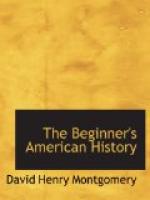If he found such a passage, he knew that it would be much shorter than a voyage round the globe further south; because, as any one can see, it is not nearly so far round the top of an apple, near the stem, as it is round the middle.
[Illustration: Map showing how Captain Hudson hoped to reach Asia by sailing northwest from England.]
Hudson could not find the passage he was looking for; but he saw mountains of ice, and he went nearer to the North Pole than any one had ever done before.
53. The Dutch hire Captain Hudson; he sails for America.—The Dutch people in Holland had heard of Hudson’s voyage, and a company of merchants of that country hired the brave sailor to see if he could find a passage to Asia by sailing to the northeast.
He set out from the port of Amsterdam,[1] in 1609, in a vessel named the Half Moon. After he had gone quite a long distance, the sailors got so tired of seeing nothing but fog and ice that they refused to go any further.
Then Captain Hudson turned his ship about and sailed for the coast of North America. He did that because his friend, Captain Smith of Virginia, had sent him a letter, with a map, which made him think that he could find such a passage as he wanted north of Chesapeake Bay.
[Footnote 1: See map in paragraph 62.]
54. Captain Hudson reaches America and finds the “Great River.”—Hudson got to Chesapeake Bay, but the weather was so stormy that he thought it would not be safe to enter it. He therefore sailed northward along the coast. In September, 1609, he entered a beautiful bay, formed by the spreading out of a noble river. At that point the stream is more than a mile wide, and he called it the “Great River.” On the eastern side of it, not far from its mouth, there is a long narrow island: the Indians of that day called it Manhattan Island.
55. The tides in the “Great River”; Captain Hudson begins to sail up the stream.—One of the remarkable things about the river which Hudson had discovered is that it has hardly any current, and the tide from the ocean moves up for more than a hundred and fifty miles. If no fresh water ran in from the hills, still the sea would fill the channel for a long distance, and so make a kind of salt-water river of it. Hudson noticed how salt it was, and that, perhaps, made him think that he had at last actually found a passage which would lead him through from the Atlantic to the Pacific. He was delighted with all he saw, and said, “This is as beautiful a land as one can tread upon.” Soon he began to sail up the stream, wondering what he should see and whether he should come out on an ocean which would take him to Asia.
[Illustration: Map showing the Great River.]
56. Hudson’s voyage on the “Great River”; his feast with the Indians.—At first he drifted along, carried by the tide, under the shadow of a great natural wall of rock. That wall, which we now call the Palisades,[2] is from four hundred to six hundred feet high; it extends for nearly twenty miles along the western shore of the river.




